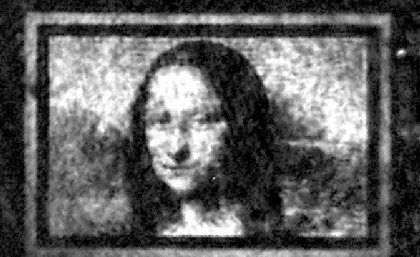May 17 2019
Physicists at the University of Queensland have recreated the Mona Lisa, Van Gogh’s Starry Night, and a lot of other images on a quantum “canvas,” with the width of a strand of human hair.
 The researchers’ rendition of the famous Mona Lisa, approximately 100 microns wide. (Image credit: The University of Queensland)
The researchers’ rendition of the famous Mona Lisa, approximately 100 microns wide. (Image credit: The University of Queensland)
The images were projected and photographed on a glob of gaseous quantum matter called the Bose-Einstein condensate.
According to Dr Tyler Neely from the UQ-based ARC Centre of Excellence for Engineered Quantum Systems, to begin with, the artworks were a fun side project aside from their more serious study.
We never aimed to do this—we were originally looking to better understand the unsolved mysteries of how fluids flow. We were hoping to gain new insights into how our everyday world arises out of the microscopic quantum world, helping us create new quantum-enhanced technologies. But, while we were at it, we just happened to create some of the world’s smallest masterpieces.
Dr Tyler Neely, ARC Centre of Excellence for Engineered Quantum Systems, The University of Queensland
A gas made of rubidium atoms was cooled down by Dr Neely and his colleagues to a few billionths of a degree Celsius above absolute zero, which is the coldest temperature possible, at −273.15 °C.
“The gas doesn’t freeze since it is too diluted, instead behaving as a blob of gaseous quantum matter,” he stated.
“We then put the image on a projector illuminated by a laser, but instead of projecting it to be large, we send it backwards through a microscope to make the image tiny.”
“This light ‘stamps’ the image on an area around about 100 microns wide—more or less the width of human hair, which can range from between 17 to 181 microns wide.”
“We can then take the image, which is only in black and white, and produce colour shots by producing a ‘red’, ‘blue’, and ‘green’ image, and then combine them on a computer.”
The ensuing image is hardly visible to the naked eye, where each pixel represents only around 50 atoms.
“One of the first images we developed was Van Gogh’s Starry Night, but we were soon recreating other works of art, famous photos, as well as photos of ourselves.”
The researchers suppose that these initial images are a splendid display of quantum matter as the newest material for creating art.
Although these images are fascinating, extending the creative expression of this medium is the next step. We’re now aiming to collaborate with an artist to help us realise a creative vision for this technology.
Dr Tyler Neely, ARC Centre of Excellence for Engineered Quantum Systems, The University of Queensland